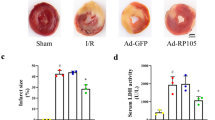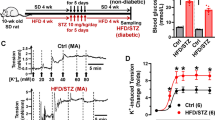Abstract
Statins are widely used in the treatment of hypercholesterolemia. Studies have demonstrated that statins could maintain vascular contractile function through inhibiting the transformation of vascular smooth muscle cells (VSMCs) from the contractile phenotype to the synthetic phenotype. However, the underlying mechanisms have not been fully elucidated. The effect of atorvastatin on the thoracic aorta of Sprague-Dawley rats cultured in serum-free conditions in vitro was evaluated. Aortic constriction was induced by high potassium, phenylephrine, and CaCl2. The protein expression levels of α1 adrenoceptor; inositol 1,4,5-trisphosphate (IP3) receptor; protein kinase Cδ (PKCδ); stromal interaction molecule 1 (STIM1); high-voltage activated dihydropyridine-sensitive (L type, Cav1.2) channels; and two contractile phenotype marker proteins [α-smooth muscle actin (α-SMA) and myosin (SM-MHC)] were determined by western blotting. Compared with the fresh control, the constriction of rat aorta was impaired after culture in serum-free medium for 24 h. The impaired contraction of cultured aortas was mediated by Cav1.2 and store-operated Ca2+ (SOC) channel, which could be improved by atorvastatin at 20 μM. The protein expression levels of α1 adrenoceptor, IP3 receptor, PKCδ, STIM1, Cav1.2, α-SMA, and SM-MHC in the aortas cultured in serum-free conditions were decreased significantly. Atorvastatin partially prevented the reduction in the contractility and the downregulation of these proteins in cultured aortas. The transformation of the VSMC phenotype is associated with the vasoconstriction dysfunction of cultured aortas. Atorvastatin may protect vascular function by modulating calcium signaling pathways.







Similar content being viewed by others
References
Chamley-Campbell J, Campbell GR, Ross R (1979) The smooth muscle cell in culture. Physiol Rev 59:1–61
Damron DS, Kanaya N, Homma Y, Kim SO, Murray PA (2002) Role of PKC, tyrosine kinases, and rho kinase in alpha-adrenoreceptor-mediated PASM contraction. Am J Phys Lung Cell Mol Phys 283:L1051–L1064
Evans AM, Wyatt CN, Kinnear NP, Clark JH, Blanco EA (2005) Pyridine nucleotides and calcium signalling in arterial smooth muscle: from cell physiology to pharmacology. Pharmacol Ther 107:286–313
Feske S, Gwack Y, Prakriya M, Srikanth S, Puppel SH, Tanasa B, Hogan PG, Lewis RS, Daly M, Rao A (2006) A mutation in Orai1 causes immune deficiency by abrogating CRAC channel function. Nature 441:179–185
Fransen P, Van Hove CE, van Langen J, Schrijvers DM, Martinet W, De Meyer GR, Bult H (2012) Contribution of transient and sustained calcium influx, and sensitization to depolarization-induced contractions of the intact mouse aorta. BMC Physiol 12:9
Gollasch M, Haase H, Ried C, Lindschau C, Morano I, Luft FC, Haller H (1998) L-type calcium channel expression depends on the differentiated state of vascular smooth muscle cells. FASEB J 12:593–601
Goyal R, Mittal A, Chu N, Zhang L, Longo LD (2010) α1-adrenergic receptor subtype function in fetal and adult cerebral arteries. Am J Physiol Heart Circ Physiol 298:H1797–H1806
Graef IA, Chen F, Chen L, Kuo A, Crabtree GR (2001) Signals transduced by Ca2+/calcineurin and NFATc3/c4 pattern the developing vasculature. Cell 105:863–875
Granfeldt D, Harbecke O, Bjorstad A, Karlsson A, Dahlgren C (2006) Neutrophil secretion induced by an intracellular Ca2+ rise and followed by whole-cell patch-clamp recordings occurs without any selective mobilization of different granule populations. J Biomed Biotechnol 2006:97803
Horowitz A, Menice CB, Laporte R, Morgan KG (1996) Mechanisms of smooth muscle contraction. Physiol Rev 76:967–1003
Husain S, Young D, Wingard CJ (2004) Role of PKCalpha and PKCiota in phenylephrine-induced contraction of rat corpora cavernosa. Int J Impot Res 16:325–333
Ihara E, Hirano K, Hirano M, Nishimura J, Nawata H, Kanaide H (2002) Mechanism of down-regulation of L-type Ca2+ channel in the proliferating smooth muscle cells of rat aorta. J Cell Biochem 87:242–251
Kamigaki M, Sasaki T, Serikawa M, Inoue M, Kobayashi K, Itsuki H, Minami T, Yukutake M, Okazaki A, Ishigaki T, Ishii Y, Kosaka K, Chayama K (2011) Statins induce apoptosis and inhibit proliferation in cholangiocarcinoma cells. Int J Oncol 39:561–568
Khalil RA, Granger JP (2002) Vascular mechanisms of increased arterial pressure in preeclampsia: lessons from animal models. Am J Phys Regul Integr Comp Phys 283:R29–R45
Kizub IV, Pavlova OO, Johnson CD, Soloviev AI, Zholos AV (2010) Rho kinase and protein kinase C involvement in vascular smooth muscle myofilament calcium sensitization in arteries from diabetic rats. Br J Pharmacol 159:1724–1731
Lin ZH, Xie LD, Wu KG, Wang HJ, Xu CS (1999) Effects of fluvastatin on structure and function of resistant vessels in spontaneously hypertensive rats. Acta Pharmacol Sin 20:855–860
Liu L, Liu J, Gao Y, Yu X, Dou D, Huang Y (2014) Protein kinase Cdelta contributes to phenylephrine-mediated contraction in the aortae of high fat diet-induced obese mice. Biochem Biophys Res Commun 446:1179–1183
Morita T, Yamawaki H, Okada M, Hara Y (2010) Contractile characteristics of rat mesenteric artery after organ culture. J Vet Med Sci 72:1621–1627
Owens GK, Wise G (1997) Regulation of differentiation/maturation in vascular smooth muscle cells by hormones and growth factors. Agents Actions Suppl 48:3–24
Ozaki H, Karaki H (2002) Organ culture as a useful method for studying the biology of blood vessels and other smooth muscle tissues. Jpn J Pharmacol 89:93–100
Pelaia G, Gallelli L, Renda T, Fratto D, Falcone D, Caraglia M, Busceti MT, Terracciano R, Vatrella A, Maselli R, Savino R (2012) Effects of statins and farnesyl transferase inhibitors on ERK phosphorylation, apoptosis and cell viability in non-small lung cancer cells. Cell Prolif 45:557–565
Pulver RA, Rose-Curtis P, Roe MW, Wellman GC, Lounsbury KM (2004) Store-operated Ca2+ entry activates the CREB transcription factor in vascular smooth muscle. Circ Res 94:1351–1358
Quignard JF, Harricane MC, Menard C, Lory P, Nargeot J, Capron L, Mornet D, Richard S (2001) Transient down-regulation of L-type Ca2+ channel and dystrophin expression after balloon injury in rat aortic cells. Cardiovasc Res 49:177–188
Stancu C, Sima A (2001) Statins: mechanism of action and effects. J Cell Mol Med 5:378–387
Stevenson AS, Gomez MF, Hill-Eubanks DC, Nelson MT (2001) NFAT4 movement in native smooth muscle. A role for differential Ca2+ signaling. J Biol Chem 276:15018–15024
Tsai MH, Jiang MJ (2006) Rho-kinase-mediated regulation of receptor-agonist-stimulated smooth muscle contraction. Pflugers Arch Eur J Physiol 453:223–232
Vig M, Peinelt C, Beck A, Koomoa DL, Rabah D, Koblan-Huberson M, Kraft S, Turner H, Fleig A, Penner R, Kinet JP (2006) CRACM1 is a plasma membrane protein essential for store-operated Ca2+ entry. Science 312:1220–1223
Wamhoff BR, Dixon JL, Sturek M (2002) Atorvastatin treatment prevents alterations in coronary smooth muscle nuclear Ca2+ signaling in diabetic dyslipidemia. J Vasc Res 39:208–220
Wamhoff BR, Bowles DK, Owens GK (2006) Excitation-transcription coupling in arterial smooth muscle. Circ Res 98:868–878
Wier WG, Morgan KG (2003) Alpha1-adrenergic signaling mechanisms in contraction of resistance arteries. Rev Physiol Biochem Pharmacol 150:91–139
Worth NF, Rolfe BE, Song J, Campbell GR (2001) Vascular smooth muscle cell phenotypic modulation in culture is associated with reorganisation of contractile and cytoskeletal proteins. Cell Motil Cytoskeleton 49:130–145
Zhang SL, Yeromin AV, Zhang XH, Yu Y, Safrina O, Penna A, Roos J, Stauderman KA, Cahalan MD (2006) Genome-wide RNAi screen of Ca2+ influx identifies genes that regulate Ca2+ release-activated Ca2+ channel activity. Proc Natl Acad Sci U S A 103:9357–9362
Acknowledgments
This work was supported by the National Natural Science Foundation of China (No. 81302779, No. 81273516, No. 81470440, No. 81370295) and Guangdong Provincial Medical Science Foundation (No. A2015229).
Author information
Authors and Affiliations
Contributions
FR, XMW, and CYD conceived and designed the research.
FZ, HY, SJK, and FLW conducted the experiments.
YQD and YMX analyzed the data.
FZ and FR wrote the manuscript.
SLW edited the manuscript.
All authors read and approved the manuscript.
Corresponding authors
Ethics declarations
Conflict of interest
The authors declare that they have no conflict of interest.
Electronic supplementary material
ESM 1
(DOCX 100 kb)
Rights and permissions
About this article
Cite this article
Zhou, F., Rao, F., Deng, YQ. et al. Atorvastatin ameliorates the contractile dysfunction of the aorta induced by organ culture. Naunyn-Schmiedeberg's Arch Pharmacol 392, 19–28 (2019). https://doi.org/10.1007/s00210-018-1559-4
Received:
Accepted:
Published:
Issue Date:
DOI: https://doi.org/10.1007/s00210-018-1559-4




